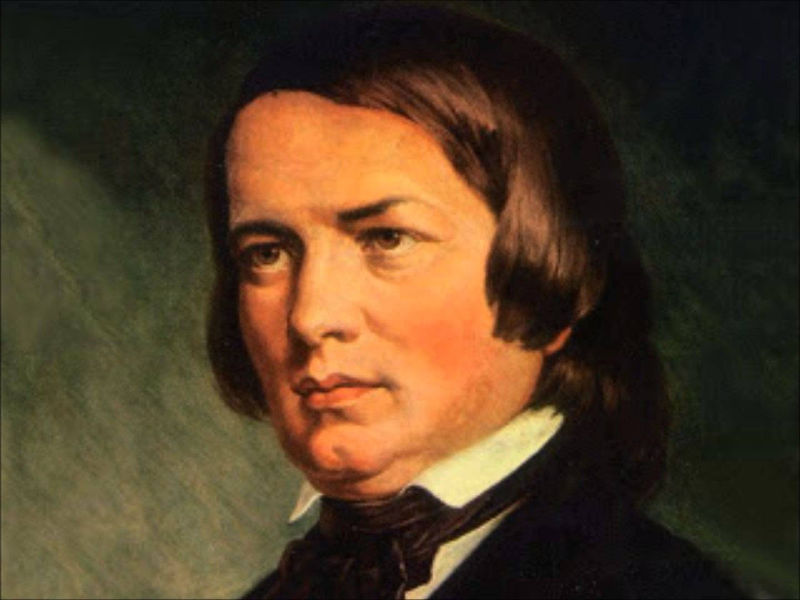|
||
|
Schumann's fourth symphony is now widely regarded as one of his most original and inventive works. In departing radically from the classical forms of Haydn, Mozart and Beethoven, it paved the way for the great late romantic symphonies of Brahms and Dvorak. Much of its innovation lies in the unity and cohesiveness of the work. Schumann called it a "symphony in one movement". Virtually all the thematic material can be traced to the mysterious slow introduction, where a "generative" motif is played by the second violins and bassoons. The lively questing allegro that follows is built from a semiquaver figure derived by inverting the generative motif and breaking it with an octave leap. The second movement is a romance in which the symphony's slow introduction reappears as the middle section. The scherzo theme is the inversion of the generative motif, but given a completely different character by the rhythm, dynamics and orchestration. Unusually the trio is played a second time, and is joined seamlessly to the final movement by a short passage of great solemnity and nobility, dominated by four horns and three trombones, with the first violins interjecting the semiquaver theme of the first movement. The final movement mirrors the first, using the same musical ideas but now in the major key, replacing the troubled uncertain mood with one of joy and triumph. Just to confound the musical analysts, Schumann introduces a closing theme which is the only one not related in any way to the generative motif. The symphony did not immediately meet with a favourable reception. The first version was completed in 1841 and given to Clara Schumann as a birthday present. Schumann called it his "Clara Symphony", a name that is now rarely used. The first performance took place in Leipzig, with Schumann himself conducting, and was a disaster. Several factors seemed to contribute to this. Firstly, there was insufficient rehearsal time devoted to the work, and the orchestral players were unfamiliar and uncomfortable playing Schuman's new symphonic idioms. Secondly, Schumann himself was a notoriously poor conductor. His introverted nature, and lack of confidence in his own work, prevented him from interacting well with the musicians and providing the necessary guidance. Thirdly some of the orchestral parts were very difficult. In particular the horn parts were not well written for the valve-less "waldhorn" which were normally used at that time. Disappointed by its failure, Schumann withdrew the work and only returned to it ten years later, after the completion of his less radical C major symphony and highly successful Rhenish symphony. The premiere of the second version took place in Dusseldorf in 1853, shortly before Schumann attempted suicide and was confined to an asylum. The majority of the revision was to the orchestration. The orchestral textures were thickened, with more instruments playing each part. It was suggested by Brahms that this was to cover up the inadequacy of some of the players in the Dusseldorf orchestra. The more instruments that played a particular passage the more likely it was that at least some of them would get it right. The second version was a success, with the eminent musicologist George Grove describing it as "a landmark in the history of the symphony". The failure of the first version of the symphony has been the source of heated critical debate. It became very common in the late nineteenth and early twentieth century to criticise Schumann's orchestration. Particularly vituperative in his criticism was Adam Carse (music master at Winchester college and writer of instructive violin pieces for young students) who said " . . (Schumann) lacked the instinct to distribute his musical materials in places where they would best contribute to the overall impression, his tone is monotonous and consistently dull, he fails to balance melodic and harmonic elements . .". On the other hand Johannes Brahms, who obtained the manuscript of the first version after Schumann's death and published in 1890 against the wishes of Clara Schumann, believed the original version to be better than the revision. He wrote "It is a real pleasure to see anything so bright and spontaneous expressed with corresponding ease and grace. Everything is so absolutely natural that you cannot imagine it in any other way - there are no harsh colors, no forced effects." Despite Brahms' championship the later version of the symphony is the one that is most commonly performed. However, the first version is now no longer considered difficult by the modern professional orchestra, and a recent recording, conducted by John Eliot Gardiner, does seem to vindicate Brahms' judgment of the work. Schumann's fourth symphony was performed by the Portobello orchestra on the 2nd July 2011, conducted by Anthony Weeden. back |

